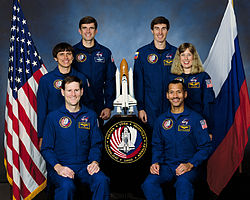STS-60
| Mission emblem | |||
|---|---|---|---|

|
|||
| Mission dates | |||
| Mission: | STS-60 | ||
| COSPAR-ID : | 1994-006A | ||
| Crew: | 6th | ||
| Begin: | February 3, 1994, 12:10:00 UTC | ||
| Starting place: | Kennedy Space Center , LC-39A | ||
| Landing: | February 11, 1994, 19:19:22 UTC | ||
| Landing place: | Kennedy Space Center, Lane 15 | ||
| Flight duration: | 8d 7h 9m 22s | ||
| Earth orbits: | 130 | ||
| Rotation time : | 91.7 min | ||
| Orbit inclination : | 59.9 ° | ||
| Apogee : | 386 km | ||
| Perigee : | 358 km | ||
| Covered track: | 5.4 million km | ||
| Payload: | WSF, BremSat, Spacehab | ||
| Team photo | |||
 v. l. No. Front: Kenneth Reightler, Charles Bolden; Middle: Franklin Chang-Diaz, Jan Davis; Back: Ronald Sega, Sergei Krikaljow |
|||
| ◄ Before / After ► | |||
|
|||
STS-60 ( english S pace T ransportation S ystem) is a mission designation for the US Space Shuttle Discovery ( OV -103) of NASA . The launch took place on February 3, 1994. It was the 60th space shuttle mission and the 18th flight of the space shuttle Discovery.
team
Main team
-
Charles Bolden (4th space flight), commander

-
Kenneth S. Reightler (2nd space flight), pilot

-
Jan Davis (2nd space flight), mission specialist

-
Ronald M. Sega (1st spaceflight), mission specialist

-
Franklin Chang-Diaz (4th space flight), mission specialist

-
Sergei Krikaljow (3rd space flight), mission specialist ( Roskosmos ) Russia

This was the first flight by a NASA spacecraft with a representative from the Russian space agency on board.
replacement
-
Vladimir Titov for Krikalev

Mission overview
The Wake Shield Facility (WSF) was the mission's primary payload. Its purpose was the growth of high-purity gallium arsenide layers under the excellent vacuum conditions of Earth orbit by means of molecular beam epitaxy . The parabolic WSF with a diameter of 3.6 m should be exposed from the manipulator arm of the shuttle and in formation flight up to 75 km away from the Discovery to achieve optimal vacuum conditions. The experimental setup was on the back of the WSF shield, which was aligned perpendicular to the direction of flight and ensured a high-purity vacuum in the "slipstream" due to the speed in orbit. The WSF was developed by the Space Vacuum Epitaxy Center at the University of Houston .
The experiment initially turned out to be impractical because the status lights on the WSF could not be seen in bright sunlight and a malfunction was suspected. The next attempt there were problems with the position control sensors of the WSF, which is why it was again not suspended. Eventually the WSF was activated while it remained at the end of the manipulator arm. Two layers of gallium arsenide could be made during one sleep period of the astronauts. Due to the problem with the position control's horizon sensor, it was decided not to suspend the WSF and to carry out all the remaining test series while the WSF was on the robot arm. Five more crystal layers were created before a final attempt could not be made due to a telemetry problem.
In the Spacehab module, biotechnological, metallurgical and pharmaceutical experiments were carried out. Special equipment for the automatic sequence of biological experiments and for the production of pharmaceutical and biotechnological preparations was put into operation (Bioserve Pilot Lab, Commercial Generic Bioprocessing Experiment, Organic Separation Experiment, Penn State Biomodule). Changes in the immune system during flight were examined in rats. The production of pure protein crystals was already a routine part of the program. There are more than 300,000 different proteins in the human body. The recording of the accelerations that the spacecraft experiences as a result of the movements of the crew members is also routine. For the first time, however, an apparatus was used that registers and measures these accelerations in three dimensions. A special mixing process for different metals (liquid phase sintering) was tested in a melting furnace in order to obtain stronger, lighter and more durable metals for cutting tools, ball bearings and use in electronics. To calibrate a radar system on earth for the detection of space debris, six metal balls were exposed (ORACS experiment). By tracking the trajectories of these spheres, the Haystack Orbital Debris Radar in Massachusetts could be accurately set. The spheres, only a few centimeters in size, orbited the earth for up to 200 days.
On February 8, a radio and television link was established between the Discovery and the three cosmonauts on board the Mir space station . At that time the orbiter was over the Pacific and the Mir over the USA.
On February 9, BremSat , a small satellite from the University of Bremen weighing only 63 kg , was released from the payload bay. It was built by OHB-System and carried out environmental observations. It recorded micrometeorites, dust particles and accelerations caused by irregularities in the earth's gravitational field and burned up in the earth's atmosphere after about a year of operation.
During the mission, repairs were made to the domestic water system and the air circulation unit. The Discovery landed on runway 33 at the Kennedy Space Center in Florida. For the first time on board a space shuttle, Sergei Krikalev was a Russian spaceman. Among other things, he carried out experiments on acceleration measurement (Space Acceleration Measurement System).
See also
Web links
- NASA Mission overview (English)
- Video summary with comments of the crew (English)
- STS-60 in the Encyclopedia Astronautica (English)
